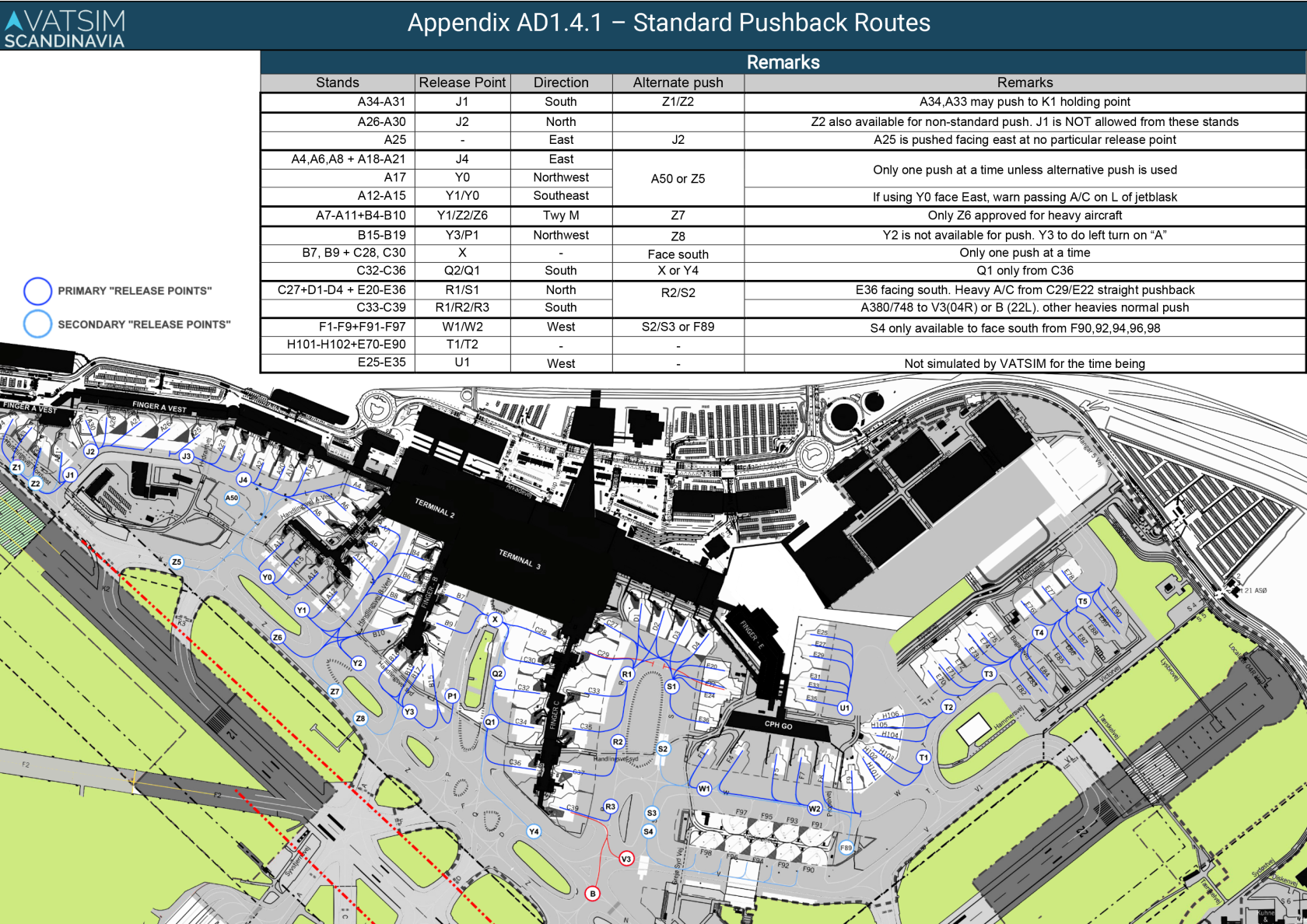! ! ! WIP ! ! ! EKCH - Copenhagen/Kastrup
Available stands
Overview
Copenhagen - Kastrup airport is the biggest in Scandinavia with 25.000.000 passengers served in 2023.
Use of stands
TheIn westKastrup, pierthere ofare the3 main terminalterminals. Terminal 1 is thefor airportsSchengen domesticflights, terminal,Terminal and2 thefor eastNon-Schengen pier& Terminal 3 is the international terminal. As a rule of thumb (though not set in stone), international flights should park at the east side of the new terminal, from stand 38 through stand 53, and remote parking 181 through 187. Domestic flights should park at the western side of the new terminal, stands 2 through 26, and remote stands 171 through 178. All flights to or from a non-schengen country should use stand 42, 43, 44, 45, 46 (46R), 47, 48, 49, 50, 51 or 53. Stand 42, 43, 44 and 45 are flexi stands, and can also be used for schengen flights. The gates at the north pier are combo gates and can be used for both domestic and international flights. The apron and terminal on the western side of runway 19R/01L is the General Aviation area. Airline traffic does not utilize the western apron.flexible.
IFR clearance
Initial contact is with Clearance Delivery, reporting callsign, stand number, and latest ATIS identification letter.
Requesting De-Icing
If you require de-ice prior to your departure, request with your departure clearance request.
DCL: Include clearence request with Remark REQ DEICE
Voice: Upon inital contact with GARDEMOEN DELIVERY, advise if de-ice is required.
Push-back
All stands require pushback (except F89 - F91 & Prop/Bizz-jet at A25 - A34) All stands have a designated release point,points and a secondary point. HoweverHowever, ATC can deviate from standard procedures if it's more optimal for the current traffic situation.
If you for some reason is unable to perform a pushback to one of these points, you MUST inform the controller when asking for pushback!
Taxi
Taxi instructions at Gardermoen includes the full taxi route, however the runway intersection is not always included. If for example “holding point runway XX” is stated in your instruction, you may call ATC with “CALLSIGN, ready via ” as you approach this intersection, and it may be approved if traffic permits. Make sure to double-check if you are able to use the runway length from the intersection before requesting it. On runway 01R, always expect to use full length via B1 or B2, due to noise abatement and SID procedures.
Runways
Given that you’ve parked according to the paragraph describing the Use of stands, usually the eastern runway (19L/01R) is used for international departures/arrivals, and the western (19R/01L) for domestic departures/arrivals. This however is not a set rule, and runways are organized to accommodate high traffic loads. The western runway (19R/01L) has a TORA of 3600m, the eastern runway (19L/01R) has a TORA of 2950m.
During winter operations the airport normally operates with a segregated runway configuration, landing on 01R/19R and departing 01L/19L.
SIDs
All SIDs are individually numbered for each runway. When receiving your clearance, know that the SID stated is only valid for one runway, in case the controller forgets to state the departure runway. RNAV SIDs at Gardermoen has an initial climb altitude of 7000ft. If you are unable to follow the published SIDs (old AIRAC, default or non-database freeware aircraft, etc.), state so when requesting clearance and you will recieve an alternative departure instructions depending on assigned runway and aircraft type.
STARs
Oslo airport Gardermoen is one of the first airports in Europe to use a “Point Merge System”, or PMS. This means that all STARs end up in a “fan” made out of waypoints (study the STAR charts for Gardermoen), in which pilots should always be prepared for a direct routing towards the merge waypoint, 4 in total, in order to ease the workload of approach ATC. All STARs are valid for both parallel runways, 19L/R or 01L/R. Expect Approach ATC to inform you of which runway to expect.
The last fix of the STAR (or Merge Point) is followed by a transition to the ILS approach for each runway. ATC often replace these with vectoring, but always be prepared to fly the transition, and do NOT fly direct from the merge point to the Final Approach Fix. If you have no transitions available, inform ATC and request vectoring. Study the approach charts, and make sure to always follow altitude and speed restriction, unless otherwise instructed by ATC
Approach
The default approach to Gardermoen is ILS for all runways. All runways are CATIII equipped. In case of low visibility conditions, only the right runway is used for landing (01R or 19R). RNP approaches are available on request. Visual approach is not approved for any jet aircraft, only props may request visual approach.
Direct routings
In Norway, direct routings are often used. Both arriving and departing traffic should be prepared to fly direct the end of SIDs, STAR Merge Points, and airspace border fixes. Make sure you have your filed route and waypoint page available to quickly accommodate direct routings.

